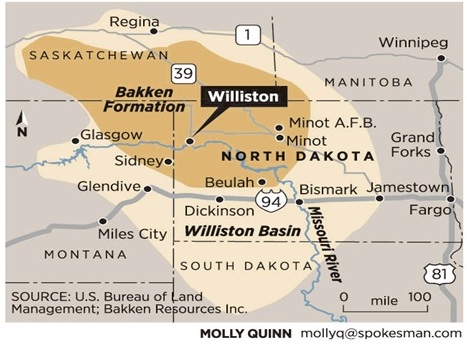When we talk about nuclear waste, it is almost always with respect to uranium mining, uranium fuel production, spent nuclear fuel and nuclear laboratories. I have written in the past about the ubiquity of uranium in rocks and soil all over the world. Uranium is forty times more common than silver. It combines with many different minerals in many different forms. We experience "normal background radiation" from the uranium in the ground which varies from place to place. There are other sources of nuclear waste or at least, waste materials that have radioactive constituents. Among these are the waste products from coal fired power plants and the waste products brought to the surface from fracking operations.
Fracking is a process where water, sand and various combinations of chemicals are force into a deep well under high pressure. The rock is fractured and the sand and chemicals help to keep the fractures open while oil and natural gas are released. Fracking has spread across the United States to the point where the U.S. is one of the major producers of natural gas in the world. This bounty of natural gas has lowered the price of energy to the point where some nuclear reactors have been unable to compete with natural gas for the production of electricity. On the down side, fracking is polluting the ground water and the wells in many areas with toxic chemicals and also causing earthquakes in areas that were previously quiet. And, the sludge that is pumped back to the surface from a fracking operation contains radioactive materials.
Under North Dakota ND, lies part of the Bakken Oil Shale Formation. North Dakota is home to massive fracking operation to release oil and natural gas from the Bakken Formation and is number two in U.S. oil production. In North Dakota there have been about three hundred oil spills in the last two years from fracking wells. Oil is oozing up out of the ground around the fracking operations. It is mixed with corrosive chemicals and something called technologically enhanced normally occurring radioactive material or TENORM. TENORM is produced when normally occurring radioactive material is brought to the surface by a fracking operation. From a legal standpoint, TENORM is supposed to be disposed of at a regulated TENORM waste site such as the one in Colorado. However, in order to reduce costs and time, producers in ND have been dumping TENORM in the closest and most convenient place they can find. (It was reported recently that fracking sludge containing TENORM was spread on roads in Pennsylvania during and after snow storms with a level of radioactivity that was not legal.)
In North Dakota, the fracking producers are not legally required to report oil spills at their operations and in their pipelines. The TENORM that is leaking out of their wells is mixing with ground water and soil and spreading beyond their production areas. It is a threat to human health and the whole environment. It is absolutely critical to the health and well being of the citizens of North Dakota that the laws are changed and vigorously enforced with respect to the reporting and control of oils spills from fracking sites.
